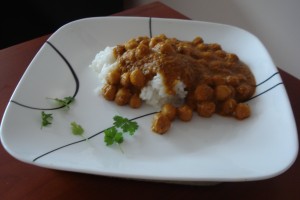Last week I finally got a chance to try a curry recipe I’ve been intending to make for some time, Chettinad Curry. After having a Chettinad numerous times at various restaurants around the city, I was anxious to try my own hand at this dish. Chettinad curries I’ve had in the past rely heavily on dark and aromatic spices, cinnamon, clove, cardamom, anise, allspice, mace, etc. I worked off a recipe in one of my go-to curry cookbooks, but as usual, I changed the method and some ingredients to suit my cooking style and ingredient stock. I also decided to use chickpeas, where normally this recipe would call for chicken. As usual, I treat most curry recipes as a recipe for sauce that can be used on any sort of meat or vegetable (or in my case, legume). Here is the result:
2 teaspoons poppy seeds
1/2 cup grated coconut
1 teaspoon fennel seeds
1 teaspoon ground cinnamon
3 green cardamoms
scant 1/4 teaspoon ground cloves
1 teaspoon turmeric
1 teaspoon garam masala
1/2 cup oil
1 large onion, chopped
1 tablespoon ground ginger
2 teaspoons garlic, minced
1/4 teaspoon anise
1 teaspoons red pepper (cayenne or paprika, depending on your heat tolerance)
1 (15oz) can of diced tomatoes in juice
1 tablespoons lime juice
2 (14oz) cans of chickpeas, drained, or 1 lb. meat (cubed) or vegetables
1 (14oz) can of coconut milk
fresh cilantro or coriander chutney for garnish
Combine all ingredients up to and including lime juice in the bowl of a food processor and puree. Transfer to a pan and saute the mixture for a few minutes, then add the meat, vegetable or legume or your choice. Add the coconut milk and stew until your contents reach their desired doneness. Meat can be stewed covered for a few hours, chickpeas could simply be heated through, or cooked until some of the liquid evaporates for a thicker sauce. Serve with rice and/or bread. Garnish with cilantro or chutney.
So, this recipe was quite tasty. The only thing was I’m not entirely sure it really tasted like a Chettinad Curry… or at least not quite like the Chettinad curries I’ve had in restaurants. I understand that Chettinad cuisine is probably quite varied and the curries called “Chettinad” on a menu may just be a small sampling. I also took a good bit of liberty by using coconut milk instead of the larger amount of grated coconut called for in the recipe. The poppy seeds didn’t strike me as particularly like any Chettinad curry I had before, and yet I much enjoyed the flavor they added.
In sum, I enjoyed this curry very much, and though it was not what I had expected, it was ultimately quite delicious and a dish I will certainly make again.


